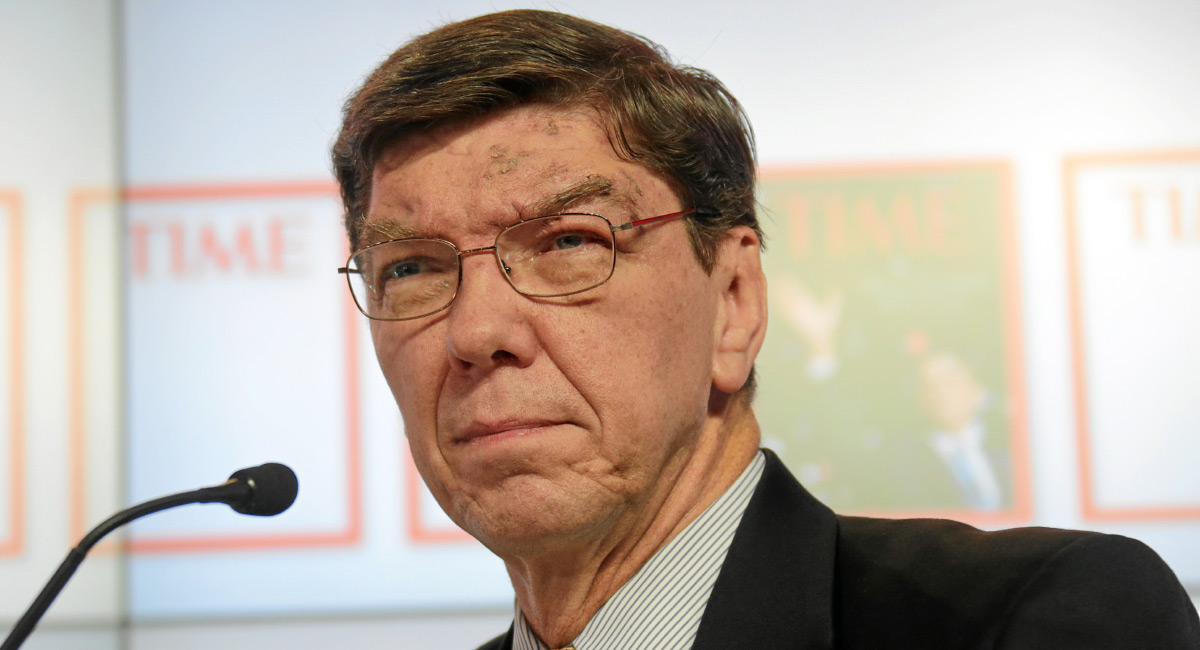Like many professors raised in a liberal arts tradition, I generally do not think particularly highly or reverentially of business school faculty professing to explain how businesses click, what defines success, etc. One big exception, however, is Clayton M. Christensen, who took one big idea about the power of innovation to disrupt and change our lives, and ran with it. Professor Christensen sadly died recently after years of battling poor health, and it is worth reflecting a bit on his Big Idea. Before doing so, I should add that he was an extraordinary man in many other respects, being, for example, a Rhodes Scholar, a intensely religious person who even wrote books informed by his Mormon faith, a risk-taking investor, former company CEO, and a devoted family man.
Christensen is best known for popularizing the concept “disruptive innovation,” growing out of his 1997 highly regarded book The Innovator’s Dilemma. He then took this theme and applied it to several aspects of life (education, health care). Of particular relevant in this space was his 2011 book coauthored with Henry Eyring, The Innovative University: Changing the DNA of Higher Education.
In a sense Christensen’s work builds on and extends the much earlier work of Austrian economist Joseph Schumpeter, who is his Capitalism, Socialism, and Democracy (1942) talked about “creative destruction,” ironically originally a concept developed by Karl Marx. The modern interpretation of Schumpeterian creative destruction is that changes in technology, incomes, tastes, and so forth lead to great companies sometimes being destroyed, because they do not adequately heed the signs of changing circumstance. The creation and destruction of resources by market forces, however is the essence of a vibrant economy, and explains capitalism’s success.
Clayton Christensen talked about “disruptive innovation.” Christensen said that success often breeds the seeds of corporate destruction. For example, the invention of new technology in photography led to the bankruptcy and near demise of Eastman Kodak, once the dominant leader in traditional photography. Kodak excessively ignored the new technology and its impact.
Christensen himself had a business career before earning his doctorate at the age of 40 and entering academia at Harvard. About a decade ago, he turned his attention to higher education, arguing that technology could and would disrupt higher education, leading to the demise of a large number, potentially, thousands, of traditional colleges and universities. The old ways of a professor standing before an audience of a few dozen or even a few hundred students and listening to him or her speak was costly and often did not convey lots of learning, so technology and innovation would lead to changes that would force many traditional schools to die or merge into other institutions with radical changes in the way business was conducted.
Christensen’s book with Eyring occurred, perhaps not coincidentally, at the exact time when college enrollments peaked. According to the National Student Clearinghouse, in the fall of 2011 the unduplicated headcount of 19,791,149 was over 1,825,000 greater than that enrollment eight years later, 2019. “Disruptive innovation” has been at work to a considerable extent, and schools slow to embrace change perhaps have been most endangered.
There are, however, important differences between competitive free market capitalism and the environment of higher education. Information is not provided as well (the profit or stock price “bottom line” is non-existent), incentives are muted by the non-profit model (higher ed has no billionaires like Bill Gates or Jeff Bezos), all of which stymies innovation. Great seemingly disruptive innovations, like MOOCs (massive open on-line courses) often do not end up showing as much promise as initially predicted. Restrictions on innovation (e.g., accreditation) are present in higher education: Tesla or the iPhone never had to become “accredited.”
All of these things mute “disruptive innovation” or “creative destruction,” as does large taxpayers and philanthropic support. If Christensen’s Harvard closed doors today it would still make an annual “profit” measured in billions from its near $40 billion endowment. Nonetheless, while creative destruction does not work as fiercely in higher ed, it still is present to some extent, and universities that do not change with such challenges as improved on-line education, the evolution of non-degree coding academies, etc., are starting to bite the dust, as the late Clayton Christensen predicted years ago.













